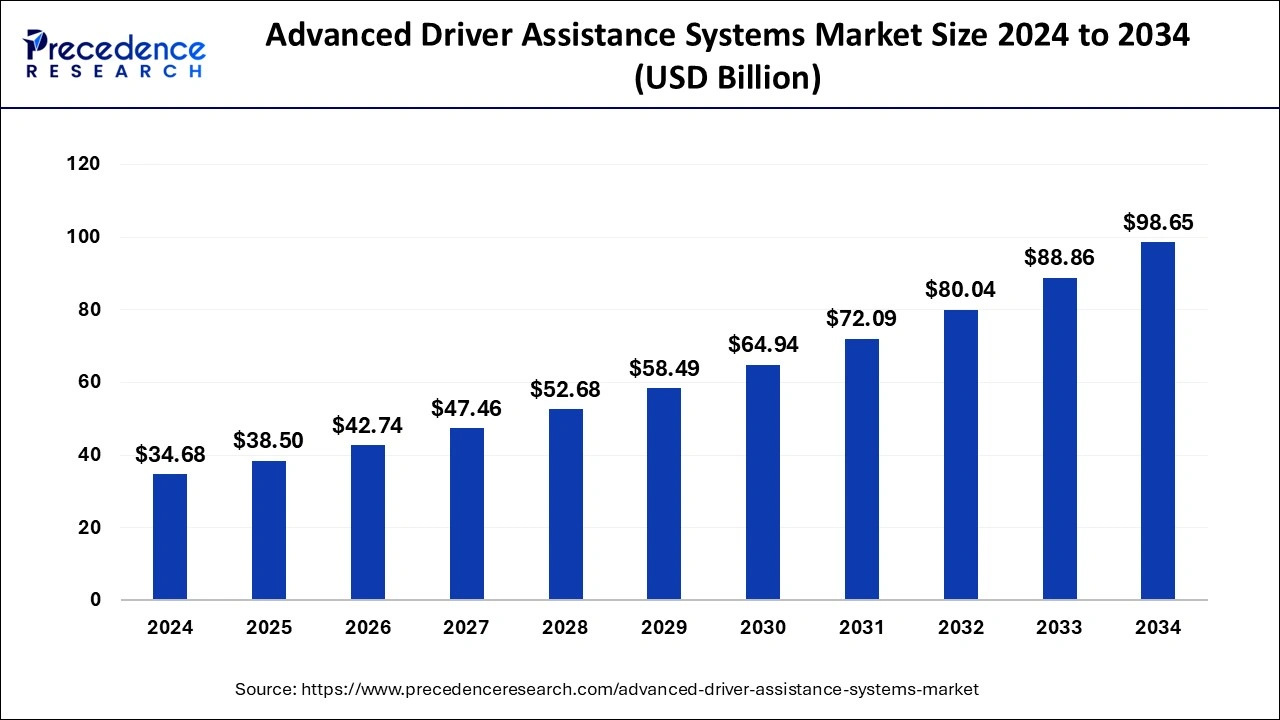The ADAS market is set to expand at a CAGR of 11.02%, reaching USD 98.65 billion by 2034 from USD 34.68 billion

Advanced Driver Assistance Systems Market Key Takeaways
- The LiDAR sensors segment dominated the market share in 2024 by component type.
- The software segment is projected to grow steadily from 2025 to 2034.
- The commercial car segment is expanding at a CAGR of 17.3% by vehicle type.
- In 2024, the tire pressure monitoring system segment held over 20.7% of the market share by solution type.
- The autonomous emergency braking segment is expected to achieve a CAGR of 21.5% during the forecast period
Advanced Driver Assistance Systems (ADAS) Market Overview
The Advanced Driver Assistance Systems (ADAS) market is experiencing rapid expansion as the demand for safer and more intelligent vehicles grows. These systems leverage cutting-edge technologies, including AI, machine learning, and sensor fusion, to provide real-time assistance to drivers and improve road safety. Key ADAS features such as automatic emergency braking, adaptive cruise control, and traffic sign recognition are becoming standard in many vehicles. With increasing regulatory pressure to enhance vehicle safety and the shift toward autonomous mobility, ADAS is set to play a crucial role in shaping the future of transportation.
Market Drivers
Several factors are driving the growth of ADAS adoption. Governments worldwide are implementing stricter safety regulations, mandating features like automatic braking and lane departure warnings in new vehicles. Rising consumer expectations for convenience, comfort, and safety are also encouraging automakers to integrate ADAS into their models. The ongoing development of connected vehicle technology and advancements in sensor accuracy further support market growth. Moreover, the increasing use of AI and deep learning in ADAS is enhancing decision-making capabilities, making these systems more reliable and efficient.
Opportunities in the Market
The expansion of autonomous vehicle technology presents immense opportunities for ADAS growth. As vehicles transition toward higher levels of automation, ADAS features will become increasingly sophisticated and essential. The demand for electric vehicles (EVs) is another major opportunity, as automakers integrate ADAS to enhance EV safety and efficiency. The aftermarket segment also holds potential, with companies developing retrofitting solutions to equip older vehicles with ADAS capabilities. Additionally, partnerships between automotive manufacturers and tech firms are fostering innovations that will drive ADAS adoption in both personal and commercial vehicle markets.
Challenges Facing the Market
Despite its promising growth, the ADAS market faces several hurdles. The high cost of ADAS components and the complexity of integrating these systems into vehicles make widespread adoption challenging, particularly in price-sensitive markets. Reliability concerns, such as false alarms and sensor malfunctions, impact consumer trust in ADAS functionalities. The lack of standardized regulations across different countries creates inconsistencies in adoption rates and system requirements. Furthermore, cybersecurity threats pose a growing risk as ADAS-equipped vehicles rely on digital connectivity, making them vulnerable to hacking and data breaches.
Regional Insights
The adoption of ADAS varies across regions. Developed markets such as North America and Europe are leading the way, driven by strict safety mandates and consumer demand for high-tech vehicles. The Asia-Pacific region, particularly China, Japan, and South Korea, is witnessing strong ADAS growth due to rapid advancements in automotive technology and increasing government incentives for smart mobility solutions. Meanwhile, emerging markets in Latin America, Africa, and the Middle East are gradually adopting ADAS, with growing investment in infrastructure and automotive safety initiatives.
Recent Developments
The ADAS industry has seen a surge in innovation, with manufacturers focusing on enhancing AI-driven automation and improving sensor technology. Companies are investing in next-generation driver monitoring systems, vehicle-to-infrastructure communication, and real-time hazard detection. The push toward autonomous driving is accelerating ADAS advancements, with automakers conducting extensive testing of self-driving technology. Additionally, legislative efforts in various regions are shaping the adoption of ADAS, as governments implement new policies to promote vehicle safety and reduce road fatalities.
Advanced Driver Assistance Systems (ADAS) Companies
- Denso
- Aptiv
- Robert Bosch GmbH
- Continental AG
- Magna International
- Veoneer
- Hyundai Mobis
- ZF Friedrichshafen
Segments Covered in the Report
By System Type
- Intelligent Park Assist (IPA)
- Lane Departure Warning (LDW)
- Road Sign Recognition (RSR)
- Tire Pressure Monitoring System (TPMS)
- Night Vision System (NVS)
- Automatic Emergency Braking (AEB)
- Adaptive Cruise Control (ACC)
- Adaptive Front Light (AFL)
- Blind Spot Detection (BSD)
- Cross Traffic Alert (CTA)
- Driver Monitoring System (DMS)
- Forward Collision Warning (FCW)
- Others
By Sensor Type
- Image Sensors
- Ultrasonic Sensors
- LiDAR
- Radar Sensors
- Infrared (IR) Sensors
- Laser Sensors
By Vehicle Type
- Passenger Car
- Light Commercial Vehicle
- Truck
- Bus
By Level of Autonomy
- L1
- L2
- L3
- L4
- L5
By Electric Vehicle
- Battery Electric Vehicles (BEV)
- Hybrid Electric Vehicles (HEV)
- Plug-in Hybrid Electric Vehicle (PHEV)
- Fuel Cell Electric Vehicle (FCEV)
By Geography
- North America
- U.S.
- Canada
- Europe
- U.K.
- Germany
- France
- Asia-Pacific
- China
- India
- Japan
- South Korea
- Malaysia
- Philippines
- Latin America
- Brazil
- Rest of Latin America
- Middle East & Africa (MEA)
- GCC
- North Africa
- South Africa
- Rest of the Middle East & Africa
Ready for more? Dive into the full experience on our website!
https://www.precedenceresearch.com/